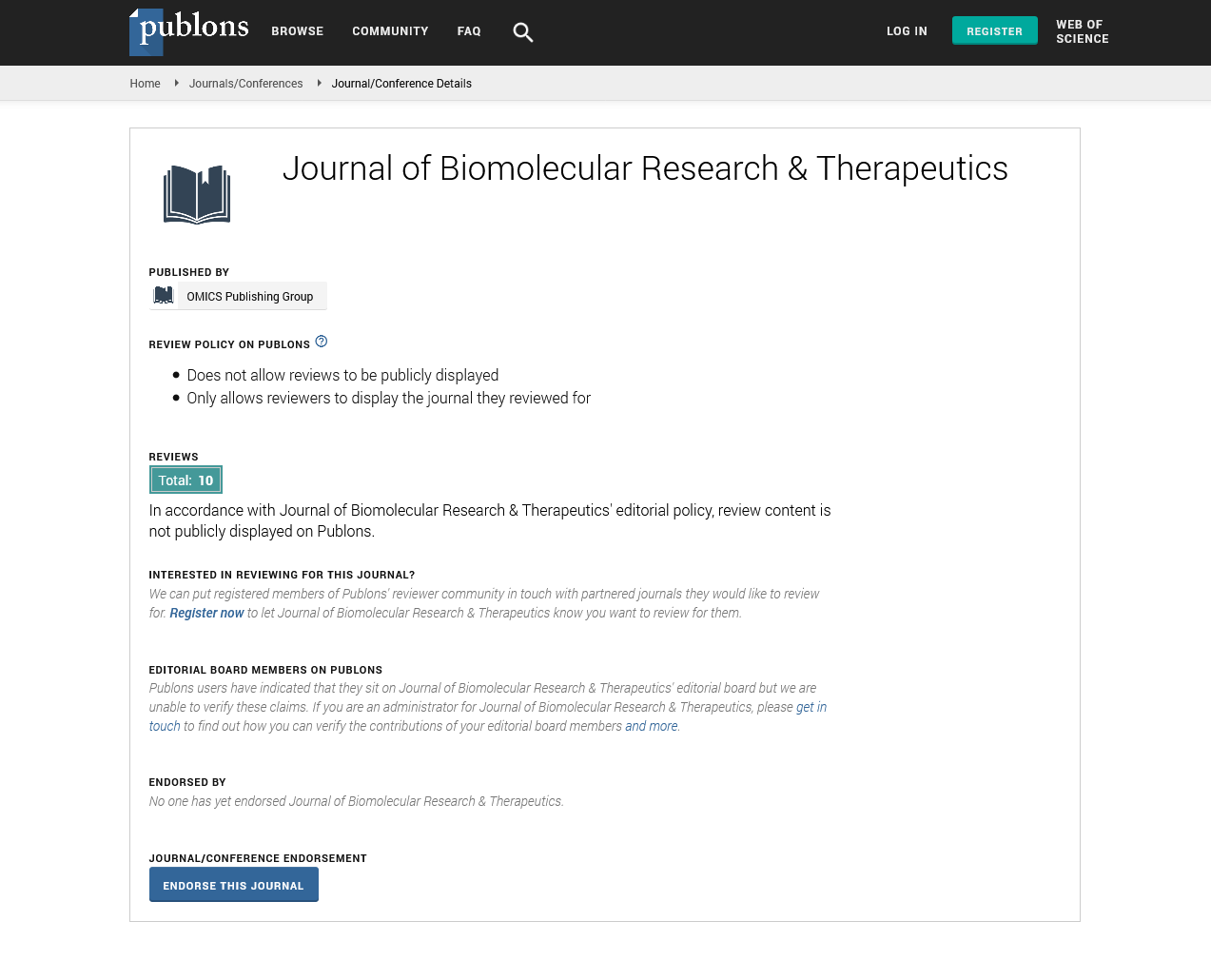Indexed In
- Open J Gate
- Genamics JournalSeek
- ResearchBible
- Electronic Journals Library
- RefSeek
- Hamdard University
- EBSCO A-Z
- OCLC- WorldCat
- SWB online catalog
- Virtual Library of Biology (vifabio)
- Publons
- Euro Pub
- Google Scholar
Useful Links
Share This Page
Journal Flyer

Open Access Journals
- Agri and Aquaculture
- Biochemistry
- Bioinformatics & Systems Biology
- Business & Management
- Chemistry
- Clinical Sciences
- Engineering
- Food & Nutrition
- General Science
- Genetics & Molecular Biology
- Immunology & Microbiology
- Medical Sciences
- Neuroscience & Psychology
- Nursing & Health Care
- Pharmaceutical Sciences
Commentary - (2025) Volume 14, Issue 1
Small Molecule Modulators of NLRP3 Inflammasome Assembly for Treatment of Autoimmune Disorders
Wang Liwei*Received: 27-Jan-2025, Manuscript No. BOM-25-29319; Editor assigned: 29-Jan-2025, Pre QC No. BOM-25-29319; Reviewed: 12-Feb-2025, QC No. BOM-25-29319; Revised: 18-Feb-2025, Manuscript No. BOM-25-29319; Published: 26-Feb-2025, DOI: 10.35248/2167-7956.25.14.424
Description
Autoimmune diseases are characterized by abnormal immune responses wherein the body’s immune system mistakenly attacks its own cells and tissues. Among the numerous molecular pathways implicated in the pathogenesis of these disorders, the NLRP3 (NOD-like receptor family, pyrin domain containing inflammasome) has emerged as a central player in promoting chronic inflammation and immune dysregulation. The NLRP3 inflammasome is a multi-protein complex that acts as a sensor for cellular stress, infection and metabolic dysfunction. Upon activation, NLRP3 oligomerizes and recruits the adaptor protein ASC (apoptosis-associated speck-like protein containing a CARD), which in turn activates caspase-1. Activated caspase-1 cleaves pro-inflammatory cytokines pro - IL - β1 and pro-IL-18 into their active forms and induces pyroptotic cell death. This process contributes to tissue damage in various autoimmune diseases such as rheumatoid arthritis, systemic lupus erythematosus, multiple sclerosis and inflammatory bowel disease. Therefore, targeted modulation of NLRP3 inflammasome assembly using small-molecule inhibitors presents a promising therapeutic strategy for controlling excessive inflammation and restoring immune balance in autoimmune disorders.
In this study, we report the discovery and characterization of a new class of small-molecule modulators capable of selectively inhibiting the assembly and activation of the NLRP3 inflammasome. Our approach began with a High-Throughput Screening (HTS) campaign of a chemically diverse compound library comprising over 25,000 molecules. The screening was conducted using THP-1 human monocytic cells stably expressing a fluorescent caspase-1 reporter, allowing for rapid quantification of inflammasome activation in response to Lipopolysaccharide (LPS) and nigericin stimulation. From this screen, we identified several hit compounds with dose-dependent inhibition of caspase-1 activity, among which compound SMM-23 demonstrated the most potent and selective inhibition profile without inducing cytotoxicity at concentrations up to 50 μM. Subsequent medicinal chemistry optimization of SMM-23 led to the development of structurally related analogs, with SMM-23B emerging as a lead candidate. Structure-Activity Relationship (SAR) analysis revealed that the aromatic urea core of the molecule was critical for its bioactivity, while substitutions at the para-position significantly modulated its inhibitory potency. SMM-23B exhibited an IC50 of 75 nM for caspase-1 activation and completely abolished IL - 1 β secretion in LPS/nigericin-treated human macrophages. Notably, it had no significant effect on TNF or IL-6 production, indicating specificity for NLRP3- mediated signaling. Mechanistic studies using confocal microscopy and co-immunoprecipitation confirmed that SMM-23B prevented NLRP3 oligomerization and its interaction with ASC, thereby blocking inflammasome assembly at an early stage.
To further investigate the specificity of SMM-23B, we assessed its activity against other inflammasomes such as AIM2, NLRC4 and NLRP1. In all cases, SMM-23B failed to inhibit inflammasome activation, suggesting a selective mechanism of action targeting NLRP3. Surface Plasmon Resonance (SPR) and Cellular Thermal Shift Assays (CETSA) demonstrated direct binding of SMM-23B to the NACHT domain of NLRP3, stabilizing its inactive conformation and preventing ATP-dependent conformational changes required for inflammasome activation. Furthermore, molecular docking simulations supported these findings and revealed key hydrogen bonding and hydrophobic interactions between SMM-23B and the ATP-binding pocket of NLRP3.
In vitro efficacy of SMM-23B was evaluated in primary monocytes derived from patients with rheumatoid arthritis and systemic lupus erythematosus. Treatment with SMM-23B led to a significant reduction in IL - 1 β and IL-18 release in patient-derived cells, with concurrent attenuation of caspase-1 activation and pyroptotic cell death. These findings highlighted the potential translational value of this compound in suppressing pathologic inflammasome activity in autoimmune conditions.
We next assessed the pharmacokinetic and safety profile of SMM-23B in rodent models. The compound displayed good oral bioavailability (48%), moderate half-life (6.5 hours) and low hepatic metabolism. Acute and subchronic toxicity studies showed no significant changes in liver and kidney function biomarkers, hematological parameters, or histopathological signs of tissue damage at doses up to 100 mg/kg. Importantly, SMM-23B did not impair normal immune responses to bacterial infection or LPS challenge, suggesting that its action is selective for aberrant, chronic inflammasome activation rather than basal immune defense.
In vivo efficacy of SMM-23B was validated in two preclinical mouse models of autoimmune disease. In the Collagen-Induced Arthritis (CIA) model, daily oral administration of SMM-23B (25 mg/kg) significantly reduced paw swelling, joint inflammation and cartilage erosion compared to vehicle-treated controls. Histological analyses showed marked reduction in synovial hyperplasia and immune cell infiltration. In a Dextran Sulfate Sodium (DSS)-induced colitis model, SMM-23B treatment led to reduced weight loss, improved colon length and decreased mucosal damage, with a substantial drop in IL - 1β levels in colonic tissues. These therapeutic effects were comparable to those observed with MCC950, a known NLRP3 inhibitor, but SMM-23B showed a longer half-life and improved oral bioavailability.
Taken together, our findings support the development of SMM-23B as a novel, orally available, selective small-molecule modulator of the NLRP3 inflammasome. Its favorable pharmacokinetic profile, robust anti-inflammatory effects and specificity for pathological inflammasome activation make it a promising candidate for further preclinical development. Given the broad role of NLRP3 in autoimmune and autoinflammatory diseases, including multiple sclerosis, gout, type 1 diabetes and even neuroinflammatory disorders such as Alzheimer's disease, SMM-23B may offer a versatile and targeted therapeutic approach to manage chronic inflammation without global immunosuppression. Future studies will aim to evaluate its efficacy in additional disease models and assess long-term safety and tolerability in higher animal systems, paving the way for clinical translation.
Citation: Liwei W (2025) Small Molecule Modulators of NLRP3 Inflammasome Assembly for Treatment of Autoimmune Disorders. J Biol Res Ther. 14:424.
Copyright: © 2025 Liwei W. This is an open access article distributed under the terms of the Creative Commons Attribution License, which permits unrestricted use, distribution AND reproduction in any medium, provided the original author and source are credited.

